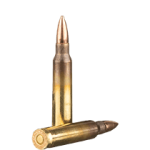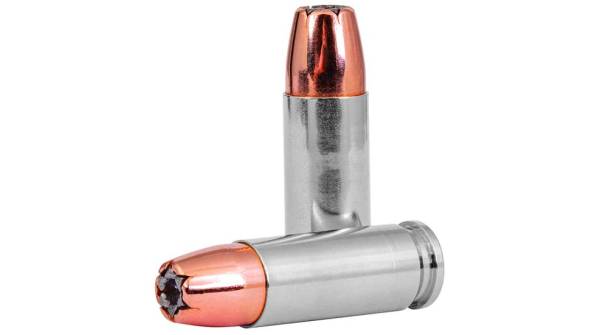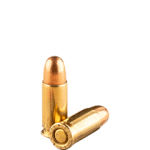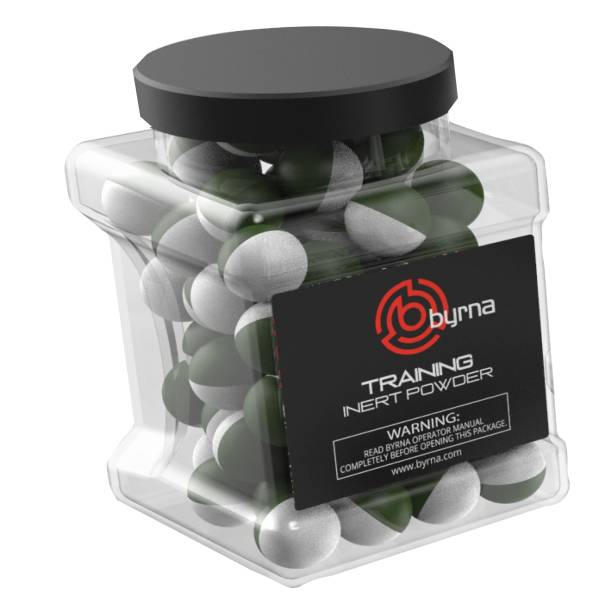Description
Perhaps one of the most iconic military cartridges, the 5.56x45mm NATO ammunition, commonly referred to as the 5.56 NATO, has been in active use in the United States Armed Forces since 1964.
5.56×45 NATO ammo features a rimless and tapered bottleneck case that measures 44.70mm (1.76 inches) in length and ranges from a 6.43mm diameter at its neck to a 9.58mm diameter at its base. This casing houses a boat-tailed bullet with a diameter of 5.70mm, or .224 inch. With both bullet and shell, the 5.56 cartridge reaches 57.40mm (2.26 inch) in length.
While the original 5.56x45mm bullet was 55 grain (gr) of lead, the standard bullet now weighs 62 gr and consists of a lead base topped with a steel penetrator. The added weight increases the ammunition’s penetration and velocity, improving its performance.
The ammunition uses a small rifle primer and the Sporting Arms and Ammunition Manufacturers’ Institute (SAAMI) sets the maximum pressure for the round between 55,000 and 58,000 pounds per square inch (psi), but variations are available with maximum pressures as high as 62,000 psi.
Although the round was originally designed as a military cartridge, the 5.56x45mm NATO has found a home among American civilian shooters. It’s especially popular in military-style semi-automatic carbines.
The Development of 5.56x45mm Ammunition
The 5.56×45 cartridge developed from a need for a faster firing automatic weapon and ammunition. After extensive research, the military determined it needed something that could fire small caliber, high velocity (SCHV) projectiles and do so quickly.
In 1957, the U.S. Continental Army Command (CONARC) requested Eugene Stoner, a lead engineer and designer at Armalite, for a scaled down version of his AR-10, where the “AR” stands for Armalite Rifle, not assault rifle. The AR-10, while effective, fired the first, and at the time only, NATO cartridge – the 7.62x51mm NATO, which is similar in size to the .308 Winchester.
With the request for the new firearm, CONARC also released a call for an ammunition that could go with it. The military knew what they wanted for the new ammunition, primarily a .22-caliber bullet with the following requirements:
Maintained supersonic speeds, above 1,080 feet per second (fps) at 500 yards
Penetrated an Army-issued steel helmet at 500 yards
Penetrated a .135-inch steel plate at 500 yards
Reached the ballistic performance and accuracy of M2 ball ammunition, the military version of the .30-06 Springfield
Wounded as efficiently as the M1 Carbine, which fired .30 Carbine cartridges
The CONARC required the firearm have both automatic and semi-automatic firing and weight six pounds or less. The firearm needed a magazine that could hold at least 20 rounds.
The ammunition’s development began under Springfield Armory’s Earle Harvey. Starting with a .222 Remington, Harvey lengthened the case to allow for more powder and called it the .224 Springfield. Before he could continue his work on the new military round, Springfield Armory ordered he cease, as they were working on a new rifle chambered in 7.62mm and didn’t want to have a competing round.
Stoner then turned to Frank Snow of Sierra Bullet and Robert Hutton, who worked as the technical editor of Guns & Ammo magazine, and together they collaborated on a 55 gr bullet with a muzzle velocity of 3,300 fps, which could meet the demands of CONARC’s requirements.
By 1959, the AR-15 and the 5.56x45mm cartridge were ready for their first round of testing. By 1961, marksmanship testing had 45 percent of shooters reaching expert certification, while only 22 percent could reach the same level of certification with the M14, leading to the first major order – 80,000 AR-15 rifles for the Air Force.
In 1962, Remington submitted the ammunition’s specifications to SAAMI as the civilian version of the 5.56x45mm, the .223 Remington, which it accepted. By 1964, the U.S. Army officially adopted the 5.56mm Ball Cartridge, M193, or what is commonly referred to as the 5.56 NATO, to be used with its newest firearm, the M16 (or, in civilian terms, the AR-15).
After combat testing during the Vietnam War, the 5.56 NATO and the .223 soon became one of the most popular centerfire cartridges not only in America, but internationally.
Its popularity has been reinforced with the ammunition’s light weight, as well as the light weight of the firearms chambered for it. With the 5.56 NATO, significantly more rounds could be carried both in the weapon and on the person during combat, with no more additional weight.
What’s more, the ease of use, including low bolt thrust and almost non-existent perceived recoil, made the firearm easy to shoot and more shooters were able to become proficient with the firearm and excel with it.
As time progressed, law enforcement agencies and militaries throughout the world, including many non-NATO countries, have opted for the cartridge and it’s become a favorite to an increasing number of U.S. civilians.
The Types of 5.56 NATO Ammo
The original 5.56 NATO was first loaded with a full metal jacket (FMJ) bullet weighing 55 gr that exited the barrel of the new AR-15 rifle at more than 3,200 fps. In 1984, ammunition was adopted by the nations of the North Atlantic Treaty Organization, or NATO, which is an intergovernmental military alliance between countries in North America and Europe.
With this NATO adoption came a few changes, most notably the addition of a steel penetrator tip in the bullet. Now called the M855, this bullet weighed a slightly heavier 62 gr and had a slightly lower velocity of around 3,100 fps. Although it doesn’t leave the muzzle as fast as the original 55 gr bullet, this heavier projectile has a stronger sustained velocity.
Because of these changes to the ammunition, the firearms needed slight alteration as well. With a heavier bullet (an increase of seven gr from the M193 to the M855), the firearm barrel needed a tighter rifling twist, at a ratio of 1:7, to help stabilize the bullet’s weight gain. This change in rifling led to improved penetration and greater accuracy than the original round.
Beyond the M855, other military variations arose, including the Mk318, a 62 gr barrier-blind round, and for precision marksmanship, the Mk262 Open Tip Match bullet.
For civilian shooters, 5.56 NATO cartridges can be found in a variety of configurations, including:
Full metal jacket (FMJ): FMJ rounds feature lead bullets encased, or jacketed, in copper or another hard metal; this metal jacket allows the projectile to keep its shape until impact and leads to greater penetration
Full metal jacket-boat tail (FMJ-BT): With FMJ-BT ammo, shooters get a bullet that’s both jacketed and tapered at the rear, resembling the shape of a boat; this shape allows for better accuracy and a more stable flight than other ammunitions
Hollow point boat tailed (HPBT): HPBT rounds feature a projectile that has a hollow point into the center of the bullet, as well as a boat-like shape to the back of the bullet; these cartridges are often seen in long-range hunting for big game animals and are known for their rapid expansion
Frangible: Frangible bullets don’t expand like traditional FMJ or jacketed hollow point bullets, but instead fragment into many smaller pieces; this fragmentation eliminates the risk of over penetration and can increase the size and internal damage of a wound
Open tip match (OTM): Perhaps one of the most controversial types of ammo, OTM rounds feature a jacketed lead bullet; like a hollow point, the projectile has an open tip, but unlike hollow points, it’s not designed to expand; instead the bullet has a poured core, which makes it extremely accurate and a favorite amongst competition target shooters
There are also speciality 5.56 NATO variations, including rounds like GMX by Hornady, which features a monolithic construction that’s tougher than cooper, and the Triple Shock X (TSX) by Barnes Bullets. TSX bullets are solid copper and designed for hunting, with their consistent and uniform expansion.
The 5.56 NATO Performance
When it comes to performance, the standard 5.56 NATO proves its worth. The cartridge penetrates to a depth of 38-51 cm (15 to 20 inches) in soft tissue and, when the impact occurs at a velocity higher than 2,500 fps, the projectile is likely to fragment into multiple pieces, causing significant wound damage.
Some believe the 5.56 NATO is even strong enough to cause hydrostatic shock damage, where the soundwaves from the projectiles’ impact create tissue damage.
Even without hydrostatic shock, which is a theory and not accepted among all gun and ammunition experts, the 5.56 NATO projectile is designed to yaw after impact. When a bullet “yaws,” it moves side to side, creating a bigger wound cavity and more extensive damage than a bullet that travels a straight path.
Yet when this round is shot out of a short-barrelled carbine, it can sometimes fail to yaw and result in over-penetration and limited expansion.
The AR-15 and Bulk 5.56 Ammo
Popular worldwide, many firearm manufacturers have produced weapons chambered for the 5.56×45 cartridge – including Armalite, Bushmaster, and Colt, among others. But the most popular, by far, is Armalite’s AR-15 and the plethora of firearms that have been built in the semi-automatic AR-15 style.
Because these firearms are so prevalent, it’s become easy to find cheap 5.56 NATO ammo and 5.56x45mm bulk ammunition. Surplus 5.56 ammo can be found both in brick and mortar gun stores from coast to coast, and most major online ammunition stores.
Although most 5.56 NATO chambered firearms are semi-automatic, shooters can find pump-action rifles in the military round.
The 5.56×45 vs .223 Remington
Externally, there are no differences between the 5.56x45mm NATO and the .223 Remington. They have the same casing. Their projectiles are the same diameter. Side-by-side, there are no visible differences between the two, other than the headstamp. But inside, there are major differences, ones that can become extremely dangerous if ignored.
When discussing these two cartridges, it’s important to remember that the 5.56 NATO was designed as a military cartridge, while the .223 Remington has been designated for civilians since its onset. One was made for war, one to shoot varmint in the backyard.
It makes sense, then, that the 5.56 NATO has a different powder load, leading to a higher pressure. The military round averages a maximum pressure about 5,000 psi higher than the .223 Remington.
This pressure difference isn’t just because of powder difference (although that’s part of it), it also has to do with the difference in chamber leade. Chamber leade refers to the space between where a bullet sits at rest to where it engages in the rifling twist. The shorter the leade, the quicker the bullet engages, and the more pressure that’s created in the barrel.
Firearms chambered for the .223 have a shorter leade than those manufactured for the 5.56 NATO. Firearms manufactured for the military round have a chamber that’s actually slightly larger than those chambered for the .223 to reduce malfunctions and misfires from dirty guns, like those often seen in battlegrounds. These larger chambers have a longer leade and the 5.56 NATO is made accordingly.
So when a shooter takes the 5.56 NATO, which was designed to be fired from a rifle with a long leade, and puts it in a firearm chambered for the .223 Remington, it engages in the rifling quicker than it should and can drastically increase the pressure in the barrel, endangering not only the firearm, but the shooter as well.
Because .223 ammo is under a lower pressure than 5.56x45mm rounds, and has a shorter leade, the civilian ammunition can be fired without issue from the 5.56 NATO weapons.
To recap, it is NOT safe to fire 5.56 NATO ammunition from a firearm chambered to .223 Remington. But it IS safe to fire .223 Remington ammo from firearms chambered to the 5.56 NATO.
In many modern military-style firearms, the barrel is labeled with both chamberings, such as 5.56 NATO/.223 Rem.
An easy way to think about it is this: Consider the 5.56 NATO as a .223 +P. And like other +P ammunitions, a shooter shoulder never shoot the higher pressure ammo out of a barrel that’s not indicated for its pressure.
FAQ
What is 5.56×45 ammo?
Considered one of the most iconic military cartridges, the 5.56x45mm NATO has been used by the U.S. Armed Forces since 1964. It features a rimless, tapered bottleneck case topped with a boat-tailed bullet that has a diameter of .224 inch. The standard projectile weighs 62 grain (gr) and contains a steel penetrator. The round was born of the .223 Remington and although the rounds look extremely similar, the NATO is more powerful and many like to think of it as a .223 +P.
How much does 5.56 ammo cost?
When it comes to the price of 5.56 ammo, it depends on the type, brand, and quantity of ammo purchased. Standard 5.56 NATO cartridges start at about $0.37 a round and continue upward to more than $1.00. American Eagle 5.56 lets you shoot the high-pressure ammo that your AR-15 craves while giving you the performance you expect from Federal 5.56 at an overall lower price point. Full metal jacket ammo tends to be cheaper than specialty rounds and hollow points, while bulk ammo is the most affordable.
What is 5.56 green tip ammo?
Sometimes 5.56x45mm rounds have a painted green tip. This signifies the cartridge as military surplus, or bulk ammo, that is redistributed and sold in the commercial market. The green tip means there is a steel bar inside the bullet, increasing its penetration and power. Unlike standard FMJ rounds, ammo with a green tip can pierce some armoured tanks. If the green tip is plastic, not painted onto the metal, then the round may be a polymer-tipped .223 Hornady FTX.
What is the difference between the .223 and 5.56 ammo?
When comparing .223 and 5.56 ammo, they look almost identical in size and shape, but on the inside of the casing, they’re different. With different bullet weights, powder loads, and chamber pressure, the 5.56 NATO is a more powerful force and is often considered a .223 +P. In addition to these configuration differences, .223 rounds have a shorter leade (the space between where the cartridge sits and the rifling begins). In most cases, it is safe to shoot .223 ammo from a rifle chambered for 5.56 NATO, but not vice versa.
What guns shoot 5.56×45 ammo?
The most popular gun chambered for the 5.56x45mm NATO is, by far, the iconic Armalite-15, commonly referred to as the AR-15. The U.S. military version was known as the M16 rifle. This firearm has inspired many of the civilian semi-automatic 5.56 chambered guns, which are collectively referred to as being “AR-15 style.” In addition, other firearm manufacturers have 5.56 chambered guns including Colt and Bushmaster. Although semi-automatic is the most common configuration, pump action rifles are also available.
What does 5.56 ball ammo mean?
In military ammo terms, the word balls refers to the standard issue round that doesn’t include any special function. This term arises from before commercial ammo was manufactured and people just used powder and a ball-shaped projectile. Currently, the U.S. Armed Forces uses either FMJ or TMJ rounds for its standard issue 5.56 NATO rounds.
Does the military use 5.56 ammo?
Yes, the U.S. military uses the 5.56x45mm round. It’s also used by the North American Treaty Organization (NATO), Japan, South Korea, Taiwan, and Australia, among other countries.
Is there a difference between 5.56 ammo and 5.56 NATO ammo?
The 5.56x45mm and the 5.56 NATO are the same size cartridge and refer to the same round. The civilian version of the 5.56 is the .223 Remington. Although the cartridges look the same, the NATO version has more force and power.
Can you hunt deer with 5.56×45 ammo?
It depends. In many areas, the 5.56x45mm, or more likely the civilian version .223 Remington, is perfectly effective for deer hunting. This is especially true East of the Mississippi where forests are dense and shots are under 100 yards. In the West, the .223 and the 5.56 lack the velocity and power for the necessary long-distance shots required. Check with local regulations as well, as some areas have a minimum caliber that is larger than the .223 to ensure humane harvests. Also check laws regarding the type of firearms allowed, as some areas outlaw the use of semi-automatics rifles for deer hunting.





